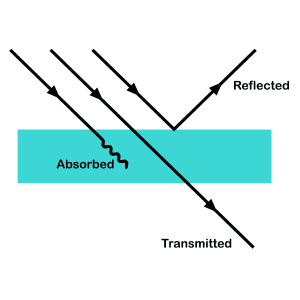The Noise Reduction Coefficient (NRC) describes the general performance of a materials sound absorptive quality. It is represented by a numerical value between 0 and 1, with 0 representing perfect reflection and 1 representing perfect absorption.
The image below helps us to understand absorption, transmission and reflection of sound in walls, pointing out why it is so important in spaces such as schools and restaurants to use decorative sound absorption panels.

It is calculated from the arithmetic average across the middle frequencies of the octave band sound absorption coefficients (250, 500, 1000 and 2000 Hertz) to the nearest 5%.
Does NRC Have Limitations?
The short answer is yes. Given that NRC is an average, comparisons between materials across the frequency spectrum cannot be accurately measured. This is important as the overall frequency spectrum is required when correctly specifying or substituting acoustic room treatment solutions. These limitations are most pronounced when we compare the effects of decorative soundproof wall panels to sound absorbing wall panels.
The below table demonstrates that a material can have an identical NRC rating to another material, however possess differences across the frequency spectrum;
| Material 1 | Material 2 | |
| Frequency | Absorption Coefficient | Absorption Coefficient |
| 250 | 0.1 | 0.5 |
| 500 | 0.3 | 0.45 |
| 1000 | 0.7 | 0.5 |
| 2000 | 1 | 0.55 |
| NRC | 0.50 | 0.50 |
Is it OK to Use NRC?!
Yes! It is perfectly fine to use NRC as an indication of a materials absorption performance, especially when dealing with architects and those who may not be familiar with the advanced areas of acoustics.
NOTE: It is important to remember that the overall absorption performance of a material cannot be determined by the NRC alone.
What are Scattering Coefficients? (Acoustics)
Scattering coefficients are now featured on our acoustic data sheets. This is in response to a high demand from acoustic consultants.
The practical use for this data is that it can be inputted in programs such as Odeon and EASE. These programs are used to simulate room acoustics in critical and/or complicated acoustic geometries.
If asked – the testing has been conducted at Sydney University in a 1:6 scale model reverberation room. The testing was conducted in general accordance with ISO 17497-1.
As far as I am aware, Supawood is the only manufacturer in Australia that provides this data!
Definition; Scattering refers to the ‘non-specular’ reflection of sound waves. Specular meaning ‘mirror like reflection’, non-specular meaning diffuse. Although, in acoustics a diffusion coefficient refers to the ‘evenness’ of non-specular reflections and that itself has its own measurement criteria. This can be confusing. The best way to consider scattering is that it refers to the non-specular reflection of sound waves that are not necessarily reflected evenly.
If you have any further questions that haven’t been answered, feel free to reach out to us and our customer care team will be happy to help.
Disclaimer: All the information on this website - www.supawood.com.au - is published in good faith and for general information purpose only. Supawood does not make any warranties about the completeness, reliability, and accuracy of this information. Any action you take upon the information you find on this website (Supawood), is strictly at your own risk. Supawood will not be liable for any losses and/or damages in connection with the use of our website.
From our website, you can visit other websites by following hyperlinks to such external sites. While we strive to provide only quality links to useful and ethical websites, we have no control over the content and nature of these sites. These links to other websites do not imply a recommendation for all the content found on these sites. Site owners and content may change without notice and may occur before we have the opportunity to remove a link that may have failed.
Consent: By using our website, you hereby consent to our disclaimer and agree to its terms.



